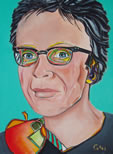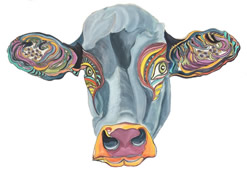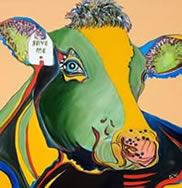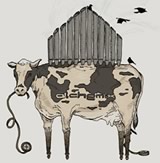useNature.com ... Ayurvedic Therapy Directory
Ayurveda Directory - What is Ghee?
Natural Health Lifestyle Online Magazine
Holistic Health & Lifestyle Information
Article: Ayurveda - What is Ghee?
Clinical application of Ghee in Ayurveda Practice
Compiled by Dieter Luske N.D.-D.C.H.-D.M.H.-D.H
Holistic Therapy Consultant - Gold Coast - Canungra
What is Ghee?
Ghee was commonly known as ghritam in the vedic period. In ancient times, people were using ghee for various purposes, as food product, and also as therapeutic agent. Unfortunately today people are not having this therapeutic knowledge of this gift of nature, and on the other hand due to improper knowledge people are having fear and may believe in myths of its consumption.
Ghee is a yellowish white fatty substance, obtained from the milk of mammals. Ayurveda considers Milk of eight kind of mammals safe for human beings; Cow, viz, buffalo, goat, sheep, camel, elephant, mare and woman.
Ghee can be prepared from this eight kinds of milk, all are safe for humans. In normal condition, cow's milk ghee is considered to be the best for human consumption.
Ayurveda considers ghee as madhur rasa (sweet taste) with Vata and Pitta dosha pacifying qualities.
It is good for the growth of the seven dhatus in the body (body fluids, blood, flesh, fat, bones, marrow and semen). It is suited to people of every age, children, young and old alike.
Ghee makes all sensory organs more efficient. It also enhance the growth of hair, formation of bones (rejoins broken bonesin injury), growth of hair and improves skin complexion.
Ghee is made up of all five elements - pruthvi, jala, agni, vayu and aakash, ( Fire, Earth, Metal, Water, Wood) which are the basic elements of the nature.
Different scholars of Ayurveda have described various uses and benefits from the Ghee.
Maharshi Charak says; ghee stimulates appetite. It balances Vata and Pitta dosha, reduces poison in the body, increases memory and intelligence. Ghee is considered as the best among all fat substances and thousands of formulas for medicated ghee are described in Charak Samhita for the treatment of various illness.
Acharya Sushruta says; ghee is sweet, soft, gentle and beneficial to the body in general. It increases jatharagni (Digestive enzymes or fire) in the body, but it is also heavy to digest. In addition to Charaka's comments, he suggest ghee for complexion, beauty and glow.
Acharya Vagbhatta describes its healing properties and special benefits in the cases of burns and weapon wounds.
There are four kinds of fat in Ayurveda;
Ghee, oil, Vasa (fat from animals) and bone marrow.
Ghee is considered as the best among all fats, due to its characteristics to absorb all the medicinal properties of the herbs with which it is fortified, without loosing its own qualities. It is heard that only cow's milk ghee can increase HDL (that is harmless to the body), all other types of fat normally increase LDL more.
Ayurveda describes Ghee as antiseptic, antibiotic and best preservative. There is no need for any other preservative for Ghee.
In Panchkarma treatments (purification and detoxification treatment), a specialized branch of treatment in Ayurveda, there is one therap, called 'Snehana", which is the first stage of purifucation, using all four kinds of fats for their therapeutic aspects.
External applications and internal uses of different kind of fat are described below:
-
Medicated or plain (pure) ghee is used here according to disease or the condition of the person.
-
Ghee is used to support - the treatments of diseases, the rejuvenative treatments (rasayana) or the aphrodisiac treatments (vajikaran).
-
Ghee can be used for treatments like:
Abhyang - massage
Akshitarpan - treatment for eys
Gandush - Gargle - full mouth filled with ghee
Pichu - ghee swab application etc. -
Internally it can be recommended for 3 to 7 days in increasing doses.
The dose can be up to 10 ml to 150 ml per day, according to disease or person's condition of the body.
Ghee in therapeutic uses:
In treatment of Headache :
Several cases of non-specific headaches or migraine were asked to consume 50 to 70 gram lukewarm ghee, early morning either plain - with milk or as 'Shira' - a sweet preparation for 7 days.
Clinically, after one week, the majority of the patients were noted significant benefits.
Headaches due to Pitta and Vata dosha can be controlled with ghee.
Particularly in summer, Pittaj shirahshul and Suryavart headaches can be controlled by this simple therapy, and will show very good results.
Article compiled by ...
the editor of Use Nature, Dieter Luske
Article provided by: Ayurvé Beauty & Wellness Day Spa
See Ayurvedic food supplements for Osteoarthritis - by the same author.
* Disclaimer - Any general advice given in any article should not be relied upon and should not be taken as a substitute for visiting a qualified medical Doctor.
 Dieter Lüske - Editor
Dieter Lüske - Editor
N.D.-D.C.H.-D.M.H.-D.H
Editor's Articles
T-shirts and otther products
Facebook Groups
Healing with Sound
Alchemix
Recording Studios
Sound Production:Recording - Mixing &
Mastering Services
Voice Overs
© 1998 - 2020 useNature.com: Australia - Natural Health and Lifestyle Directory - Allied Holistic Health Information Services
Site Map - Terms / Privacy - Global Health | Free Alpha Music | Photography | Natural Links |



